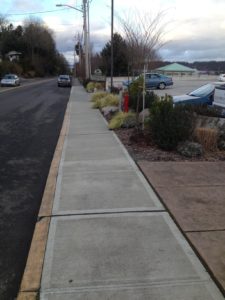Crushed Glass Structural Fill at West Bay Business Park
Case Study: Published | Updated: | | Olympia, Washington |- Category
- category_listing(s)
- Building Type
- Commercial-Retail/Office
- Innovation
- Glass Cullet as Alternative Structural Fill
- Jurisdiction
- Olympia, Washington
- Parcel
- Officials
- Fran Eide | City of Olympia, Public Works
- Team
-
Fran Eide
|
approving-official
Alan Murley | Plan Reviewer
Smci Corp | builder
Diana Wall | Other
Glenn Wells | owner
Austin Carter | contributor

Crushed glass cullet was used below a sidewalk as fill and leveling agent in place of sand and gravel at 304 West Bay Drive in Olympia, WA. The material is made up of glass otherwise unsuitable for typical glass recycling and is created at a local quarry. Due to knowledgeable building officials and engineering examiners in Olympia, the material proved to meet the IBC compaction requirements with no additional procedures to permit the project. The project was successfully completed and crushed glass cullet proved to be safe and cost effective.
Glass cullet is a familiar alternative substrate material in the Olympia area. Developers SMCI of Bremerton, WA used glass cullet infill in the construction of the sidewalk. Using the material did not slow the project timeline or add additional costs. Because glass cullet meets the compaction requirement of the IBC code used by the City of Olympia, the use of glass cullet is in compliance to the code regarding sidewalks. Because of familiarity of the product, knowledgeable engineers and building officials, permitting this project was not difficult as glass cullet is a previously approved substrate.
| Code Requirement | Compliance Path |
|---|---|
|
All fill material shall be compacted to 90 percent of maximum density as determined by ASTM D 1557, Modified Proctor, in lifts not exceeding 12 inches (305 mm) in depth. |
Provided that the sidewalk sub-grade has been compact to 90% of maximum density, outlined in the appendix J of the IBC, the use of glass cullet in this application is in compliance with the code. |